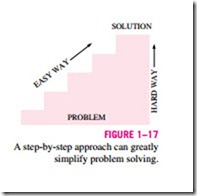PROBLEM-SOLVING TECHNIQUE
The first step in learning any science is to grasp the fundamentals, and to gain a sound knowledge of it. The next step is to master the fundamentals by putting this knowledge to test. This is done by solving significant real-world problems. Solving such problems, especially complicated ones, require a systematic approach. By using a step-by-step approach, an engineer can reduce the solution of a complicated problem into the solution of a series of simple problems (Fig. 1–17). When solving a problem, we recommend that you use the following steps zealously as applicable. This will help you avoid some of the common pitfalls associated with problem solving.
Step 1: Problem Statement
In your own words, briefly state the problem, the key information given, and the quantities to be found. This is to make sure that you understand the problem and the objectives before you attempt to solve the problem.
Step 2: Schematic
Draw a realistic sketch of the physical system involved, and list the relevant information on the figure. The sketch does not have to be something elaborate, but it should resemble the actual system and show the key features. Indicate any energy and mass interactions with the surroundings. Listing the given in- formation on the sketch helps one to see the entire problem at once. Also, check for properties that remain constant during a process (such as tempera- ture during an isothermal process), and indicate them on the sketch.
Step 3: Assumptions and Approximations
State any appropriate assumptions and approximations made to simplify the problem to make it possible to obtain a solution. Justify the questionable assumptions. Assume reasonable values for missing quantities that are necessary. For example, in the absence of specific data for atmospheric pressure, it can be taken to be 1 atm. However, it should be noted in the analysis that the atmospheric pressure decreases with increasing elevation. For example, it drops to 0.83 atm in Denver (elevation 1610 m) (Fig. 1–18).
Step 4: Physical Laws
Apply all the relevant basic physical laws and principles (such as the conservation of mass), and reduce them to their simplest form by utilizing the as- sumptions made. However, the region to which a physical law is applied must be clearly identified first. For example, the heating or cooling of a canned drink is usually analyzed by applying the conservation of energy principle to the entire can.
Step 5: Properties
Determine the unknown properties at known states necessary to solve the problem from property relations or tables. List the properties separately, and indicate their source, if applicable.
Step 6: Calculations
Substitute the known quantities into the simplified relations and perform the calculations to determine the unknowns. Pay particular attention to the units and unit cancellations, and remember that a dimensional quantity without a unit is meaningless. Also, don’t give a false implication of high precision by copying all the digits from the screen of the calculator—round the results to an appropriate number of significant digits.
Step 7: Reasoning, Verification, and Discussion
Check to make sure that the results obtained are reasonable and intuitive, and verify the validity of the questionable assumptions. Repeat the calculations that resulted in unreasonable values. For example, insulating a water heater that uses $80 worth of natural gas a year cannot result in savings of $200 a year (Fig. 1–19).
Also, point out the significance of the results, and discuss their implications. State the conclusions that can be drawn from the results, and any recommendations that can be made from them. Emphasize the limitations under which the results are applicable, and caution against any possible misunderstandings and using the results in situations where the underlying assumptions do not apply. For example, if you determined that wrapping a water heater with a $20 insulation jacket will reduce the energy cost by $30 a year, indicate that the insulation will pay for itself from the energy it saves in less than a year. How- ever, also indicate that the analysis does not consider labor costs, and that this will be the case if you install the insulation yourself.
Keep in mind that you present the solutions to your instructors, and any engineering analysis presented to others, is a form of communication. Therefore neatness, organization, completeness, and visual appearance are of utmost importance for maximum effectiveness. Besides, neatness also serves as a great checking tool since it is very easy to spot errors and inconsistencies in a neat work. Carelessness and skipping steps to save time often ends up costing more time and unnecessary anxiety.
The approach described here is used in the solved example problems with- out explicitly stating each step, as well as in the Solutions Manual of this text. For some problems, some of the steps may not be applicable or necessary. For example, often it is not practical to list the properties separately. However, we cannot overemphasize the importance of a logical and orderly approach to problem solving. Most difficulties encountered while solving a problem are not due to a lack of knowledge; rather, they are due to a lack of coordination. You are strongly encouraged to follow these steps in problem solving until you develop your own approach that works best for you.
